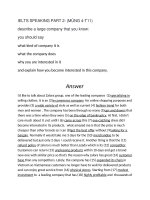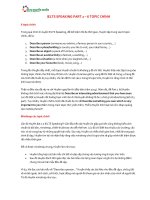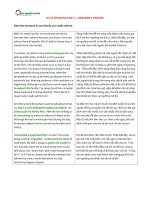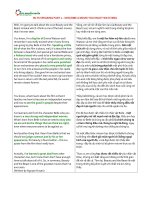PET Speaking part 2
Bạn đang xem bản rút gọn của tài liệu. Xem và tải ngay bản đầy đủ của tài liệu tại đây (198.2 KB, 12 trang )
Preliminary Speaking Part 2 – teacher’s notes
Description
To introduce and practise Part 2 of the Speaking test and to consider what makes a good performance in
Preliminary Speaking Part 2 Also to identify and practise some useful language for Preliminary Speaking
Part 2.
Time required:
60 minutes
Materials
required:
Sample task
Student’s worksheets 1 and 2
Student’s worksheet 2 Exercise 1 cut up into strips
OHT of assessment criteria
Audio or video recording of Part 2 of the Speaking test (e.g. the Preliminary
Speaking test video pack, available from Cambridge English)
transcript
to introduce and practise Part 2 of the Speaking test
to consider what makes a good performance in Preliminary Speaking Part 2
to identify and practise some useful language for Preliminary Speaking Part 2
Aims:
Procedure
1. Introduce Part 2 of the Speaking test by eliciting any information about it that your students already
know. Establish the basics by asking questions such as:
Do you work alone or with your partner in Part 2? (With your partner)
Are there any visual materials? (Yes, there are some pictures)
Is this a roleplay? (No, but you are given a situation to talk about)
2. Hand out the sample task and the student’s worksheet. Direct students to Exercise 1 on the
worksheet and ask them to discuss the questions with a partner by referring to the sample task.
3. Whole class discussion of the features of the task (see key).
4. Elicit or remind students of the assessment criteria using the OHT with the assessment criteria.
Point out that interactive communication is important in Part 2 but that candidates are assessed on
their own performance, not in relation to their partner.
5. If possible, play the video or recording of Part 2. If you don’t have access to the Speaking test video
pack, you could record yourself and two colleagues doing Part 2 as an audio recording, using the
transcript provided here. If no recording is possible, hand out the transcript for students to read
through. Ask students to consider the questions in Exercise 2 of the student’s worksheet while they
watch/listen/read.
© UCLES 2008. This material may be photocopied (without alteration) and distributed for classroom
use provided no charge is made. For further information see our Terms and Conditions.
6. Class discussion of their answers. Point out that Eva could have extended her comments about
bringing her umbrella.
7. Explain that they are now going to practise some of the functional language that might be useful in
Part 2 and refer back to the examples used by Eva and Bertha to demonstrate what this is. Give
students the cut up strips from Student’s worksheet 2 Exercise 1 with one phrase on each strip and
the separate headings. Students match the phrases and headings in pairs.
8. Hand out Student’s worksheet 2 in its complete form. Students self check the matching task.
9. Check if any phrases are unfamiliar and present and drill the pronunciation for these phrases and
allow students a few minutes to practise by themselves.
10. Explain that students are going to practise a Part 2 task with their partner, and that during it they
should use some of the functional language you’ve just been working on. Refer students to Student’s
worksheet 2 Exercise 2 and allocate one situation to each pair. Ensure a similar number of pairs are
doing each situation.
11. Ask the pairs to discuss the topic and to come to a decision only after they have talked about all five
options.
12. Go around the class, monitoring performance and language.
13. When they have finished the task, find out from each pair what they decided upon and give feedback
on language and performance. You could highlight examples of both good language and language
which needs improving or correcting and getting the students to do this themselves.
14. Divide the class into groups of three. Refer students back to the sample task. Allocate one student in
each group to be the examiner and the other two students to be candidates. Students complete the
sample task, with the examiner reading the instructions, timing 3 minutes and listening to the other
two students completing the task.
15. Go round the class, monitoring performance and language.
16. Ask each examiner for some feedback about their candidates. Encourage them to comment in a
positive way about use of phrases, turn taking and interesting vocabulary and grammar.
17. Put the following true/false statements about Part 2 on the board. Give students a few minutes to
consider them before rounding off with a discussion about the answers.
It’s more important to look at the pictures as soon as you get them than to listen to the
examiner’s instructions.
(False, you must listen carefully to what you need to do in the task, so try not to look at the pictures
immediately as you will probably get distracted and not hear the instructions properly.)
If you don’t know the correct vocabulary for one of the pictures, you should just ignore it.
(False, you should try to paraphrase what it is e.g. a wallet is something that you carry your money
and credit cards in.)
You should try to talk more than your partner
(False, a candidate who dominates the task and doesn’t give their partner a chance to speak will lose
marks. The aim is to work together and take turns.)
© UCLES 2008. This material may be photocopied (without alteration) and distributed for classroom
use provided no charge is made. For further information see our Terms and Conditions.
You should come to a decision as quickly as possible.
(False, the examiners can only give marks on the language they hear in the test. By coming to a
decision too early, the candidates are not giving themselves the opportunity to show the examiner
what they can do. Candidates should talk about all the options and give their reasons for selecting or
rejecting them.)
© UCLES 2008. This material may be photocopied (without alteration) and distributed for classroom
use provided no charge is made. For further information see our Terms and Conditions.
Preliminary Speaking Part 2 – answer keys
Key to Student’s Worksheet 1 Exercise 1
a) Look at the instructions. What do you have to do?
Talk with your partner about the things a friend of yours will need when she comes to spend 6 months in
England.
b) What kind of language will you need to do the task?
•
language for describing the objects in the pictures
•
future tense e.g. she will need
•
modal verbs e.g. she might need
•
superlatives and comparatives e.g. a camera is the most important thing to bring / a camera is more
important than a stereo
•
language for giving reasons e.g. because
•
language for giving and asking for opinions e.g. I think, what do you think?
c) Which of these speaking skills are needed for Part 2?
•
Making suggestions
Yes
•
Responding to suggestions
Yes
•
Answering personal questions
No
•
Discussing alternatives
Yes
•
Making recommendations
Yes
•
Negotiating agreement with your partner
Yes
•
Roleplay
No
•
Talking about your plans for the future
No
d) What do you think is more important, the discussion or the decision? Why?
The discussion. The examiners want to hear your language, not your ideas. They want to hear you talking
about the topic and interacting with your partner.
© UCLES 2008. This material may be photocopied (without alteration) and distributed for classroom
use provided no charge is made. For further information see our Terms and Conditions.
Key to Student’s Worksheet 1 Exercise 2
1. Do they discuss all options? Yes they do
2. Do they both speak equally? Why / why not? Although Bertha gives longer answers than Eva, they
both take turns and Eva starts and sums up the activity.
3. Do they give reasons for their opinions? Yes, there are lots of examples where they give reasons
using ‘because’
4. Does either candidate do the following?
•
Start the activity Eva ‘My friend Alicia is coming from Spain for six month because she need
to improve her English, yes?’ This is a nice way to start the activity as it makes it realistic.
•
Make a suggestion Both
•
Ask the other’s opinion Eva ‘So what do you think he has to bring with her?’
•
Show a preference Both
•
Agree or disagree Both agree a lot.
•
Keep the discussion going Bertha continues Eva’s ideas about the radio.
•
Sum up Both make a final comment.
© UCLES 2008. This material may be photocopied (without alteration) and distributed for classroom
use provided no charge is made. For further information see our Terms and Conditions.
Preliminary Speaking Part 2 – Assessment criteria
•
Grammar and Vocabulary
This includes how accurate and appropriate the candidate’s grammar and vocabulary are as well as
the range that is used
•
Discourse Management
This is how coherent, long and relevant a candidate’s answers are
•
Pronunciation
This is how clear a candidate’s English sounds are as well as their stress, rhythm and intonation. An
accent is fine as long as the candidate can be understood.
•
Interactive Communication
This is how well a candidate uses their language to communicate with their partner, including such
skills as initiating and responding, taking turns and keeping the task going.
•
Global Achievement
This is the interlocutor’s assessment of how effective a candidate is in dealing with the tasks in all four
parts of the speaking test
© UCLES 2008. This material may be photocopied (without alteration) and distributed for classroom
use provided no charge is made. For further information see our Terms and Conditions.
Preliminary Speaking Part 2 – Student’s worksheet 1
Exercise 1
Look at the sample Part 2 and discuss the following questions with a partner:
a) Look at the instructions. What do you have to do?
b) What kind of language will you need to do the task?
c) Which of these speaking skills are needed for Part 2?
making suggestions
making
recommendations
responding to
suggestions
answering personal
questions
negotiating agreement
with your partner
roleplay
discussing
alternatives
talking about your
plans for the future
d) What do you think is more important, the discussion or the decision? Why?
Exercise 2
While you are watching/ listening to/ reading the sample Part 2, think about these questions.
1. Do they discuss all options?
2. Do they both speak equally? Why / why not? Do they give reasons for their opinions?
3. Does either candidate do the following?
•
start the activity
•
make a suggestion
•
ask the other’s opinion
•
show a preference
•
agree or disagree
•
keep the discussion going
•
sum up
© UCLES 2008. This material may be photocopied (without alteration) and distributed for classroom
use provided no charge is made. For further information see our Terms and Conditions.
Preliminary Speaking Part 2 – Student’s worksheet 2
Exercise 1
Here are some useful phrases for Preliminary Speaking Part 2. Practise saying and using them.
Starting
Shall we start with this one?
Let's start with this one, shall we?
Suggesting
I think this would be good because…
This wouldn’t be such a good idea because…
Asking your partner
So, what do you think?
Do you think that’s a good idea?
Showing preferences
I prefer…
I think this is better because…
Agreeing
Yes, that’s a good point.
I see what you mean.
Disagreeing
Well, I’m not so sure about that.
I don’t think that’s such a good idea.
Choosing/summing up
Which one shall we choose?
So, shall we choose this one?
Do we agree that this is the best one?
Exercise 2
Discuss the situation your teacher tells you to. Talk about all the suggestions.
© UCLES 2008. This material may be photocopied (without alteration) and distributed for classroom
use provided no charge is made. For further information see our Terms and Conditions.
Preliminary Speaking Part 2 – Sample task
Speaking Test 1 (Trip to England)
Part 2 (2-3 minutes)
Say to both candidates:
I’m going to describe a situation to you.
A friend of yours in planning to spend 6 months in England to improve her
English. Talk together about the things she will need in England and decide
which are the most important things to take / bring with her.
Here is a picture with some ideas to help you.
Place Part 2 booklet, open at Task 1, in front of candidates.
Pause
I’ll say that again.
A friend of yours in planning to spend 6 months in England to improve her
English. Talk together about the things she will need in England and decide
which are the most important things to take / bring with her.
All right? Talk together.
Allow the candidates enough time to complete the task without intervention.
Prompt only if necessary.
Thank you. (Can I have the booklet please?)
Retrieve Part 2 booklet.
About 2-3 minutes (including time to assimilate the information)
© UCLES 2008. This material may be photocopied (without alteration) and distributed for classroom
use provided no charge is made. For further information see our Terms and Conditions.
© UCLES 2008. This material may be photocopied (without alteration) and distributed for classroom
use provided no charge is made. For further information see our Terms and Conditions.
Preliminary Speaking Part 2 – Transcript
Interlocutor:
Thank you. In the next part, you're going to talk to each other. I'm going to
describe a situation to you: a friend of yours is planning to spend six months in
England to improve her English. Talk together about the things she will need in
England and decide which are the most important things to bring with her. Here is
a picture with some ideas to help you. (Okay) I'll say that again: a friend of yours
is planning to spend six months in England to improve her English. Talk together
about the things she will need in England and decide which are the most
important things to bring with her. Alright? Talk together.
Both:
Okay
Eva:
Er…my friend Alicia is coming from Spain for six month (sic) because she need
er to improve her English, yes?
Bertha:
Uh-huh.
Eva:
So what do you think that he ... he has to bring with her?
Bertha:
Hmmm, I think she has to bring er…a lot of money and maps and the tourist
guide because I remember when I come here in London for the first time I spent a
lot of money in transport, in buying the maps and it was very useful to have the
...the map because you have to move to all London to find a job, to find a place to
sleep, an accommodation. So I think it's the most important. And also the...the
clothes (pronounced: clo-this) because it's very cold here. And it's raining.
Eva:
Yes, I forgot my umbrella when I arrived at London.
Bertha:
So you should tell, tell her that bring
Eva:
Yes
Bertha:
Yeah. Um, maybe, it's not very much important but it's very useful to have the
camera to make pictures about all the places in London, famous places like Big
Ben, to have (indistinct) the experience you have here because (Yes) it's
crazy…remember the first months you experience new things and you met a lot
of people. So maybe Alicia should bring…
Eva:
I think the most important thing is bring the radio, the cassette because if you
hear the radio every day, you can improve your English quickly.
Bertha:
Yeah, you can also use the tape from the school to make a listening exercise and
all these things. It's very useful, yeah, you learn a lot if you listen English all the
day.
Eva:
Yes
© UCLES 2008. This material may be photocopied (without alteration) and distributed for classroom
use provided no charge is made. For further information see our Terms and Conditions.
Bertha:
So I think she should be…
Eva:
So, the most important things is bring a lot of money and with money you can do
everything!
Bertha:
Everything, yeah. But if you can bring this stuff from Spain, it's better for her.
Eva:
Uh-huh.
Bertha:
Sure.
Interlocutor:
Right. Thank you.
Eva:
You're welcome.
© UCLES 2008. This material may be photocopied (without alteration) and distributed for classroom
use provided no charge is made. For further information see our Terms and Conditions.









